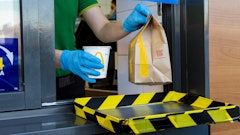
In its continuing struggle with unsaleables, the food industry finds itself winning some battles, but losing the war. As a result, renewed efforts to find solutions are underway.
Judging by the recent commitment and successes of major manufacturers and retailers, the war is far from over, but, for now, the situation is hardly encouraging. Since the first industry benchmarks were published in 1995, the average reported rate of unsaleables has grown from 0.75 percent to 1.06 percent in 2004.
"Despite the advances we have made in supply chain technologies and efficiencies, the cost of unsaleables continues to increase. To change this situation, manufacturers and retailers must work together to identify and correct the root causes of unsaleable products," says Karin Croft, senior director of industry affairs at the Grocery Manufacturing Association (GMA), based in Washington.
Last month, GMA and the Food Marketing Institute (FMI) issued recommendations for reducing unsaleable products. Developed by the Unsaleables Leadership Task Force, this new report outlines how trading partners should collaborate to fix the root causes of unsaleables and improve supply chain efficiencies. Recommendations include:
- Unsaleables should be processed through reclamation centers;
- Trading partners should use product condition data to better understand where and how damage occurs in the supply chain;
- Current data synchronization and registration initiatives should be expanded to help reduce unsaleable product volume.
In the big picture, "improvements are being made on all sides of the supply chain," reports Tom Marcellino, vice president of sales and client services at Carolina Logistics Services Inc., Winston-Salem, NC.
"One thing that we've noticed in recent years is that retailers, wholesalers and manufacturers are taking unsaleables to a level of visibility and attention within their companies," he says. "They're assigning director-level and above responsibility to the issue and they're also sharing accountability for the problem, not only among supply chain managers, but also pulling category managers and brand managers into the equation. So you're now getting sort of a broader view and certainly a broader perspective and ownership of the issue than what has been historically in place."
"But reducing the cost of unsaleables is not simple, guaranteed or enduring without a focused commitment to improvement and collaboration between the trading partners," says Croft of GMA.
Ron Romback, vice president of Genco, Pittsburgh, agrees. "Perhaps the single best outcome of dealing with unsaleables is improved collaboration between trading partners," he says. "The issues that arise while addressing unsaleables typically span the supply chain and therefore require both parties to come to the table and develop solutions. Supply chain changes and improvements are generally better accepted by all parties when they are developed together and help both companies work toward a common goal."
As a third party, Genco has experience with unsaleables and the problems they cause. There are obvious financial situations between trading partners that arise from dealing with unsaleables, but another major issue is the actual relationship between companies, Romback adds.
Genco strongly encourages its customers to participate in collaborative studies. These studies identify an unsaleables opportunity and Genco then serves as the moderator and supply chain management expert between the retailer and manufacturer. Through collaboration and in-depth analysis, Genco logisticians can then offer recommendations that reduce damages through the entire supply chain.
Leaders Recognized For Strides Made
At their Joint Industry Unsaleables Conference last year, GMA and FMI recognized four industry initiatives that had successfully addressed the challenge of reducing unsaleable costs. The recipients of the 2005 Innovation Awards were:
- Campbell Food Co. and Food Lion, for working together to identify a secondary packaging flaw in V8 and tomato juice packages in a matter of 15 days, resulting in a long-term solution for the entire supply chain.
- Kellogg USA, for developing an innovative system that delivered a 75 percent reduction in damage to Morning Food products over five years.
- Land O'Lakes, for reducing overall unsaleable percent to sales below 1 percent over a three-year period.
- MeadWestvaco Coated Board, for evaluating paper board compression and choosing paperboard substrate, which ultimately reduced unsaleables by 20 percent to 30 percent.
"The goals achieved by these companies can serve as models for others in the industry," says Croft.
Here's a look at how winners hit their goals.
Kellogg USA/Morning Foods: The Morning Foods Division of Battle Creek, MI-based Kellogg USA scored a major success in its battle with unsaleables implementing practices that reduced the damage rate by 75 percent over four years. The results came about from the work of a cross-functional unsaleables team led by the director of remarketing and returns management. The team worked with Universal Solutions, a third-party supplier that was acquired by Carolina Logistics Services.
The key to Kellogg's efforts was implementing a closed-loop returns management system in 2000. A closed-loop supply chain includes traditional forward supply-chain activities and the additional activities of returns management. According to Kellogg, returns management is "the process of enhancing the role of supply chain management for the purpose of increasing profitability for the manufacturer and the retailers."
By conducting failure analysis on returned product and evaluating product condition at the customer warehouse and retail, the returns management process creates opportunities to improve the product, packaging, distribution, marketing and sales processes."
Kellogg developed a model for the closed loop returns management system that featured a continuum of four key links, each feeding into the others:
- Data collection: Collecting significant data at regular intervals throughout the supply chain and at the customers' locations;
- Information/knowledge: Turning the data gathered into information by working with Universal to gain knowledge about each other's operating processes;
- Measurements: Developing ongoing measurement scorecards; and
- Accountability: Holding all functional areas accountable for the results.
Here is one example of the model at work:
- Finding: Product shipped on slip-sheets created 160 percent more damage in its customer warehouses.
- Solution: Discontinued customer slip-sheet financial incentives and changed to pallets only.
- Key learning: Kellogg was losing much more on unsaleables costs due to damage than it was saving on platform costs.
- Continuous improvement step: Conduct ongoing measurements of platform type and unit load dimensions on damage level. Work is underway to develop a model to predict damage levels based on unit load design and dimensions, platform type, and method of shipment.
Food Lion: At Food Lion, based in Salisbury, NC, the message has been to overcome several obstacles, including its perception of unsaleables. In previous years, unsaleables were thought of as a cost of doing business and given very little consideration.
"Today, Food Lion understands the impact that unsaleables have on our bottom line. We are putting a significant amount of effort into educating our company and our vendor partners on the impact of unsaleables," says Chris Mead, unsaleables manager.
A first step for Food Lion was to provide visibility and accountability. The retailer has added both to all levels of its organization and with the vendor community. Operations and the category management department both have bottom-line accountability for unsaleables. Vendor partners provide monthly reports that identify progress with unsaleables.
"The result of the education, visibility and accountability has been a massive reduction in unsaleables that has provided a substantial positive impact to our bottom line," says Mead.
Food Lion is also hosting several summits a year to identify opportunities to work with vendors and third-party party audit companies to reduce unsaleables. The summits provide an environment that allows the group to share ideas to help the industry tackle the problem.
"The summits have been very beneficial and we plan to continue hosting them," says Mead. "The vendor summits have increased communication and awareness of initiatives and tools that are contributing to our progress. We have seen a large increase in audits and information sharing."
Land O'Lakes: When unsalesables were close to 1.5 percent of sales at Land O'Lakes Inc. in 2002, the Arden Mills, MI-based company put together a cross-functional task force to find solutions. The focus was on three key areas:
- Supply chain: Modified pallet stretch-wrapping, changed to CHEP pallets and reduced case pack-size on several lower-velocity items.
- Sales: Implemented new retail call procedures and a "smart rotation" guide, designed a new customer warehouse check process and staffed a retail excellence team to improve in-store execution.
- Operations: Partnered with Universal Solutions to provide unsaleables tracking and reporting, and began unsaleables monthly steering team meetings.
As a result unsaleables rate declined by 50 percent from 2002 to 2005 (from 1.41 percent to 0.71 percent). There was a cost avoidance of $5.8 million from 2003 to 2005.
MeadWestvaco: MeadWestvaco Coated Board makes more than 1 million tons per year of Coated Natural Kraft (CNK), a coated unbleached kraft paperboard used to make beverage carriers and folding cartons for items like frozen food. The firm based in Phenix City, AL, has examined the details behind unsaleables.
"While unsaleables encompass many categories, including expired code dates, over-ordering, etc., more than half the returns in the supermarket industry—57 percent—are due to damage coming from packaging, handling, shipping, receiving and stocking," says Mike Skrovanek, vice president of marketing. "Therefore, if we could determine where the damage was taking place, where the product was challenged, and make significant reduction in that damage, everyone would profit."
To address unsaleables, MeadWestvaco commissioned Genco Damage Research, which tracked frozen food products through the distribution channel to supermarket freezers. GENCO researchers evaluated 21,721 cartons using unbleached and bleached board for comparable products. Bleached, or SBS, is used for three-quarters of all frozen food products while MeadWestvaco's Coated CNK was used for about 10 percent.
Of the 10,700 products packaged in CNK cartonboard, only 166 were damaged, which equates to a 1.55 percent damage rate. In comparison, 235 of the 8,488 SBS cartons were damaged, a 2.77 percent rate; and 59 of the 2,533 SUS (a competitor's unbleached coated kraft board) were damaged, for a 2.33 percent rate.
"The results substantiated that, when CNK is used to create the frozen food carton, the package more effectively protects against crushing, denting, and tearing," says Skrovanek. "The two-phase research project also concluded that almost all damage occurs after the grocer takes delivery of pallets."
Applying the third-party damage results to market costs per ton for CNK ($870) and SBS ($960) equates to a board cost (including damage) of 8.5 cents per package for CNK vs. 10.8 cents for SBS, according to Skrovanek. In purchasing terms, that means a manufacturer could realize a savings in unsaleables of $22.55 per thousand cartons or $342 per ton of board by switching to CNK.
"Food manufacturers should look at how much the paper they use is costing them in damages," says Mike Ghassali, senior vice president of Genco Damage Research, who also encourages retailers to use this information to their benefit.
"Ask any retailer what is the strongest contributor to unsaleables," he says. "It's packaging. Inferior packaging causes more damages and more touchpoints. Conversely, better packaging means less handling, which equates to less damages. That's good for everyone and avoids the hassles of disposal and submitting for refunds. Retailers who are advocating for a better packaged product should be taking note."
What's the next step going forward?
Marcellino of CLS sees an improvement in data management and information sharing throughout the supply chain. His company has invested heavily in improving the data mining tools for clients, which really allows them to manipulate and query on a large amount of returns management data provided to them as a result of processing their products.
"This allows for a more open discussion with manufacturers and vendors because they're now looking at more accurate and timely information across the supply chain, where historically that really hasn't been the case," Marcellino says.
"Once this information-sharing process begins to take hold and information is shared equally amongst the trading partners," he says, "the next step then will be to really collaborate and focus on problem resolution, understanding what the true root causes of unsaleables are, how those can be addressed throughout the supply chain, and ultimately driving down the rate of unsaleables in the industry."


























